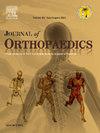机器人辅助和导航辅助全膝关节置换术的比较显示出相似的结果:一项系统回顾和荟萃分析
IF 1.5
Q3 ORTHOPEDICS
引用次数: 0
摘要
目的与传统TKA相比,计算机辅助技术可提供更好的部件对准和手术精度。然而,机器人辅助全膝关节置换术(RA-TKA)是否明显优于导航辅助全膝关节置换术(NA-TKA)仍然存在争议。因此,我们旨在进行一项荟萃分析,探讨RA-TKA与NA-TKA在膝关节骨关节炎患者中的准确性和安全性。方法系统检索PubMed、Scopus、Web of Science、Cochrane Library,检索RA-TKA与NA-TKA的比较研究。我们评估了放射学对准异常值、聚乙烯(PE)植入物厚度、手术时间和安全性结果。使用RevMan Web进行统计分析。分别对二分终点和连续终点进行95%置信区间(ci)的优势比(ORs)和平均差异(MDs)合并。由于预期异质性,采用随机效应模型,并采用I2检验进行测量。结果我们纳入了来自16项研究的19,209例患者,其中3764例(19.6%)被分配到RA-TKA。我们发现RA-TKA和NA-TKA在髋关节-膝关节-踝关节角度异常值方面无统计学差异(OR 0.91;95% CI 0.56 ~ 1.48;p = 0.71;I2 = 25%),股冠状角异常值(OR 0.46;95% CI 0.16 - 1.38;p = 0.17;I2 = 60%),胫骨冠状角异常值(OR 0.51;95% CI 0.13 ~ 2.08;p = 0.09;I2 = 58%),假体周围关节感染(OR 0.76;95% CI 0.27 ~ 2.15;p = 0.61;I2 = 0%),停留时间MD -0.17天;95% CI -1.08 - 0.74;p = 0.72;i2 = 98%)。RA-TKA使用比NA-TKA薄1.03 mm的PE刀片(MD -1.03 mm;95% CI -1.60 ~ - 0.46;p = 0.71;I2 = 98%),而NA-TKA的手术时间缩短了9.87 min (MD 9.87 min;95% CI 0.62 ~ 19.11;p = 0.04;i2 = 99%)。结论ra - tka和NA-TKA具有相当的放射对准性。虽然RA-TKA允许更薄的聚乙烯插入物,但比NA-TKA需要更长的手术时间。这些发现表明这两种技术都是足够的,具有可能影响手术决策的特定差异。本文章由计算机程序翻译,如有差异,请以英文原文为准。
Comparison between robotic-assisted and navigation-assisted total knee arthroplasty shows comparable outcomes: A systematic review and meta-analysis
Purpose
Computer-assisted technology offers better component alignment and surgical precision than conventional TKA. However, whether robotic-assisted total knee arthroplasty (RA-TKA) shows clear benefits over navigation-assisted total knee arthroplasty (NA-TKA) is still contentious. Therefore, we aimed to perform a meta-analysis exploring the accuracy and safety of RA-TKA compared to NA-TKA in patients with knee osteoarthritis.
Methods
We systematically searched PubMed, Scopus, Web of Science, and Cochrane Library for studies comparing RA-TKA with NA-TKA. We assessed radiological alignment outliers, polyethylene (PE) insert thickness, surgical time, and safety outcomes. Statistical analyses were performed using RevMan Web. Odds ratios (ORs) and mean differences (MDs) with 95 % confidence intervals (CIs) were pooled for dichotomous and continuous endpoints, respectively. A random‐effects model was used due to anticipated heterogeneity and measured with the I2 test.
Results
We included 19,209 patients from sixteen studies, of whom 3764 (19.6 %) were assigned to the RA-TKA. We found no statistically significant difference between RA-TKA and NA-TKA in terms of hip-knee-ankle angle outliers (OR 0.91; 95 % CI 0.56 to 1.48; p = 0.71; I2 = 25 %), femoral coronal angle outliers (OR 0.46; 95 % CI 0.16 to 1.38; p = 0.17; I2 = 60 %), tibial coronal angle outliers (OR 0.51; 95 % CI 0.13 to 2.08; p = 0.09; I2 = 58 %), periprosthetic joint infection (OR 0.76; 95 % CI 0.27 to 2.15; p = 0.61; I2 = 0 %), and length of stay MD -0.17 days; 95 % CI -1.08 to 0.74; p = 0.72; I2 = 98 %). RA-TKA used 1.03 mm thinner PE inserts compared with NA-TKA (MD -1.03 mm; 95 % CI -1.60 to −0.46; p = 0.71; I2 = 98 %), whereas surgical time was 9.87 min shorter with NA-TKA (MD 9.87 min; 95 % CI 0.62 to 19.11; p = 0.04; I2 = 99 %).
Conclusions
RA-TKA and NA-TKA had comparable radiological alignment. While RA-TKA allows for thinner polyethylene inserts, it requires longer surgical time than NA-TKA. These findings suggest that both techniques are adequate, with specific differences that may influence surgical decision-making.
求助全文
通过发布文献求助,成功后即可免费获取论文全文。
去求助
来源期刊

Journal of orthopaedics
ORTHOPEDICS-
CiteScore
3.50
自引率
6.70%
发文量
202
审稿时长
56 days
期刊介绍:
Journal of Orthopaedics aims to be a leading journal in orthopaedics and contribute towards the improvement of quality of orthopedic health care. The journal publishes original research work and review articles related to different aspects of orthopaedics including Arthroplasty, Arthroscopy, Sports Medicine, Trauma, Spine and Spinal deformities, Pediatric orthopaedics, limb reconstruction procedures, hand surgery, and orthopaedic oncology. It also publishes articles on continuing education, health-related information, case reports and letters to the editor. It is requested to note that the journal has an international readership and all submissions should be aimed at specifying something about the setting in which the work was conducted. Authors must also provide any specific reasons for the research and also provide an elaborate description of the results.
 求助内容:
求助内容: 应助结果提醒方式:
应助结果提醒方式:


